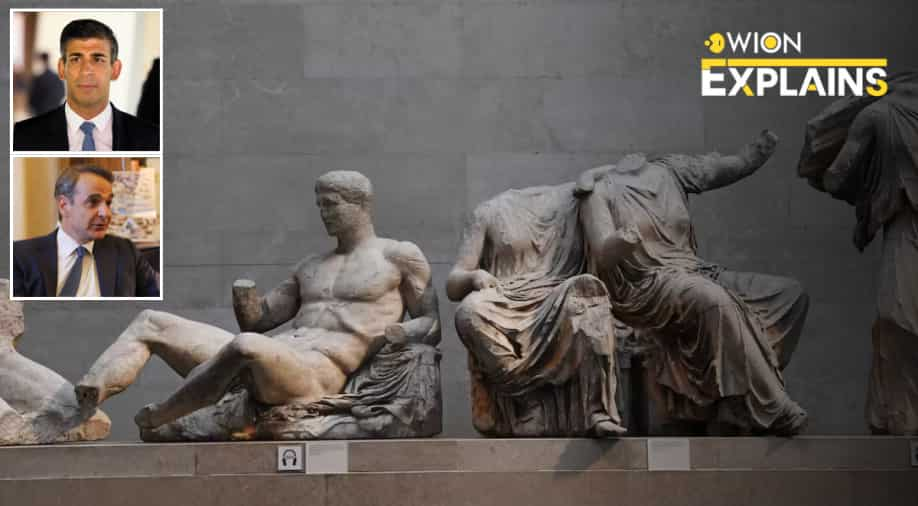Explained: The Parthenon Sculptures row between United Kingdom and Greece
Story highlights
The sculptures were taken from the Parthenon temple at the Acropolis in Greece in the early 19th century by the British ambassador to the Ottoman Empire, then ruling Greece Thomas Bruce, the Earl of Elgin. For a very long time, Athens has campaigned for their return
United Kingdom Prime Minister Rishi Sunak cancelled a meeting with his Greek counterpart scheduled to take place on Tuesday (November 28) over the Parthenon Sculptures, also known as the Elgin Marbles, triggering a diplomatic row between the two nations.
Greek PM Kyriakos Mitsotakis expressed his disappointment over the last-minute cancellation of a bilateral meeting in London set to discuss their long-running dispute over the Parthenon Marbles. While speaking to reporters, Mitsotakis said that he was "deeply disappointed by the abrupt cancellation" of the meeting and he also rejected an alternative meeting with the deputy prime minister.
In a brief statement, the Greek leader said: "I would like to express my displeasure at the British Prime Minister's cancellation of our meeting just a few hours before it was due to take place."
trending now
He further told reporters on Monday evening that "those who firmly believe in the correctness and justice of their positions are never hesitant to engage in constructive argumentation and debate". The Greek PM added: "Greece and Britain share longstanding ties of friendship, and the scope of our bilateral relations is extensive."
"Our positions on the matter of the Parthenon Sculptures are well-known. I had anticipated engaging in a discussion with my British counterpart on this issue, as well as addressing significant global challenges such as the situations in Gaza and Ukraine, the climate crisis, and migration," Mitsotakis added.
A Downing Street spokesperson said that the "UK-Greece relationship is hugely important", without referring to the marbles issue.
As quoted by the news agency AFP, the spokesperson cited joint work within NATO and "tackling shared challenges like illegal migration" and the wars in Ukraine and the Middle East. "The deputy prime minister was available to meet with the Greek PM to discuss these important issues," the spokesperson added.
Cancellation of the meeting
The scheduled meeting was cancelled a day after Mitsotakis told BBC that the marbles should be returned. He compared the Parthenon Sculptures to the Mona Lisa painting, as he said that to have some of the artefacts in London's British Museum and the rest in Athens was like cutting the portrait by Leonardo da Vinci in half. He said it was not a question of ownership but "reunification".
"We have not made as much progress as I would like in the negotiations. I'm a patient man and we've waited for hundreds of years, and I will persist in these discussions," Mitsotakis told BBC during a programme.
"This is not in my mind an ownership question, this is a reunification argument – where can you best appreciate what is essentially one monument?" he added.
"It's as if I told you that you would cut the Mona Lisa in half, and you will have half of it at the Louvre and half of it at the British Museum, do you think your viewers would appreciate the beauty of the painting in such a way? Well, this is exactly what happened with the Parthenon sculptures," the Greek PM further added.
"We feel that the sculptures belong to Greece and that they were essentially stolen. I think the answer is very clear. They do look better in the Acropolis Museum, a state-of-the-art museum that was built for that purpose," Mitsotakis said.
Sculptures of the Parthenon
The sculptures were taken from the Parthenon temple at the Acropolis in Greece in the early 19th century by the British ambassador to the Ottoman Empire, then ruling Greece, Thomas Bruce, the Earl of Elgin. For a very long time, Athens has campaigned for their return. The main sculptural decorations of the Parthenon include the Chryselephantine statue of Athena, the East and West pediments, the metopes of the peristyle, and the continuous frieze of the cellar. The sculptures were exhibited on the exterior of the temple.
As defined by AncientGreece.org, the pediments of the Parthenon were decorated with elaborate marble statues dedicated to mythological aspects of Athena. The report stated that the huge sculptures were arranged in dynamic compositions in order to fill the confined triangular spaces. However, the sculptures of the pediments (aetomata) were reported to be damaged severely when the Parthenon was converted to a Christian church.
Notably, Athens claims that the marble was stolen, however, Britain denies it. The issue remains to be discussed with an aim to arrive at a consensus and has been a source of contention between the countries for decades.
The Acropolis Museum was built by Greece in 2009 to keep the historic sculptures that remained in the country, along with other artefacts. The Greeks wanted the rest of the sculptures to complete the collection.
Also read: Mummies of children from at least 1,000 years ago unearthed near residential area in Peru
Conflict within UK
UK-based media reports said that Mitsotakis had said that he would raise the issue with Sunak during the now-cancelled meeting on Tuesday. His remarks came after he met with the Labour leader Keir Starmer. As reported by The Financial Times, Starmer said he would not block a "mutually acceptable" loan deal between both countries for the sculptures. An important point - Starmer represents the Holborn and St Pancras constituency, where the British Museum is located.
Earlier this year in March, Sunak ruled out any change to a law that stops the British Museum from handing the marble back to Greece permanently. Sunak's spokesman said earlier Monday that the UK has "no plans" to facilitate their return to Athens.
However, it can happen as the legislation won't deny a loan.
(With inputs from agencies)

















